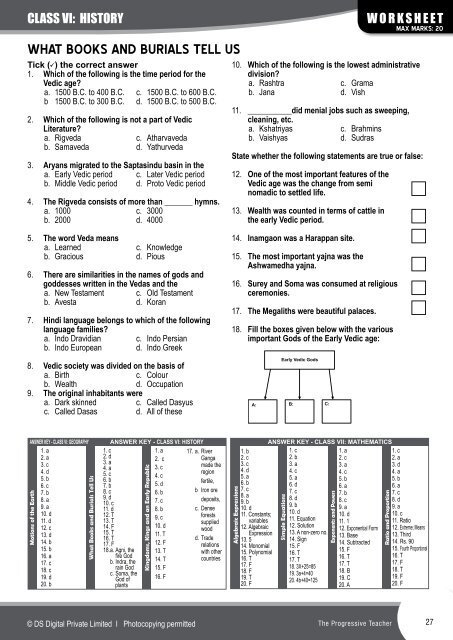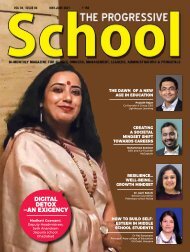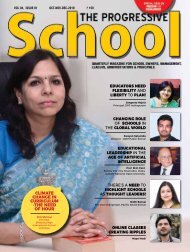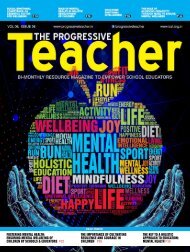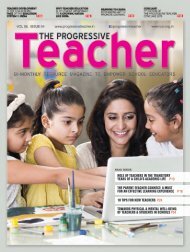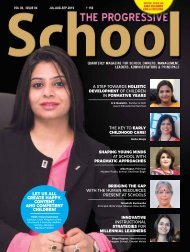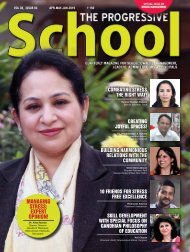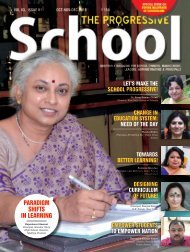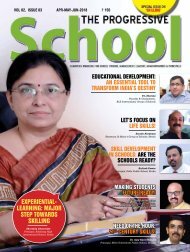The Progressive Teacher Vol 04 Issue 03
This issue of The Progressive Teacher focuses on "New Trends in Education ". In this edition, articles explore contemporary trends to enhance interactive learning amongst students.
This issue of The Progressive Teacher focuses on "New Trends in Education ". In this edition, articles explore contemporary trends to enhance interactive learning amongst students.
You also want an ePaper? Increase the reach of your titles
YUMPU automatically turns print PDFs into web optimized ePapers that Google loves.
Class VI: history<br />
What Books and Burials tell us<br />
Tick ( ) the correct answer<br />
1. Which of the following is the time period for the<br />
Vedic age?<br />
a. 1500 B.C. to 400 B.C. c. 1500 B.C. to 600 B.C.<br />
b 1500 B.C. to 300 B.C. d. 1500 B.C. to 500 B.C.<br />
2. Which of the following is not a part of Vedic<br />
Literature?<br />
a. Rigveda c. Atharvaveda<br />
b. Samaveda d. Yathurveda<br />
3. Aryans migrated to the Saptasindu basin in the<br />
a. Early Vedic period c. Later Vedic period<br />
b. Middle Vedic period d. Proto Vedic period<br />
4. <strong>The</strong> Rigveda consists of more than _______ hymns.<br />
a. 1000 c. 3000<br />
b. 2000 d. 4000<br />
worksheet<br />
Max Marks: 20<br />
10. Which of the following is the lowest administrative<br />
division?<br />
a. Rashtra c. Grama<br />
b. Jana d. Vish<br />
11. ___________did menial jobs such as sweeping,<br />
cleaning, etc.<br />
a. Kshatriyas c. Brahmins<br />
b. Vaishyas d. Sudras<br />
State whether the following statements are true or false:<br />
12. One of the most important features of the<br />
Vedic age was the change from semi<br />
nomadic to settled life.<br />
13. Wealth was counted in terms of cattle in<br />
the early Vedic period.<br />
5. <strong>The</strong> word Veda means<br />
a. Learned c. Knowledge<br />
b. Gracious d. Pious<br />
6. <strong>The</strong>re are similarities in the names of gods and<br />
goddesses written in the Vedas and the<br />
a. New Testament c. Old Testament<br />
b. Avesta d. Koran<br />
7. Hindi language belongs to which of the following<br />
language families?<br />
a. Indo Dravidian c. Indo Persian<br />
b. Indo European d. Indo Greek<br />
8. Vedic society was divided on the basis of<br />
a. Birth c. Colour<br />
b. Wealth d. Occupation<br />
9. <strong>The</strong> original inhabitants were<br />
a. Dark skinned c. Called Dasyus<br />
c. Called Dasas d. All of these<br />
14. Inamgaon was a Harappan site.<br />
15. <strong>The</strong> most important yajna was the<br />
Ashwamedha yajna.<br />
16. Surey and Soma was consumed at religious<br />
ceremonies.<br />
17. <strong>The</strong> Megaliths were beautiful palaces.<br />
18. Fill the boxes given below with the various<br />
important Gods of the Early Vedic age:<br />
Early Vedic Gods<br />
A: B: C:<br />
Answer Key - Class VI: Geography<br />
1. a<br />
2. a<br />
3. c<br />
4. d<br />
5. b<br />
6. c<br />
7. b<br />
8. a<br />
9. a<br />
10. d<br />
11. d<br />
12. c<br />
13. d<br />
14. b<br />
15. b<br />
16. a<br />
17. c<br />
18. c<br />
19. d<br />
20. b<br />
Motions of the Earth<br />
What Books and Burials Tell Us<br />
Answer Key - Class VI: History<br />
1. a<br />
2. c<br />
3. c<br />
4. c<br />
5. d<br />
6. b<br />
7. c<br />
8. b<br />
9. c<br />
10. d<br />
11. T<br />
12. F<br />
13. T<br />
14. T<br />
15. F<br />
16. F<br />
1. c<br />
2. d<br />
3. a<br />
4. a<br />
5. c<br />
6. b<br />
7. b<br />
8. c<br />
9. d<br />
10. c<br />
11. d<br />
12. T<br />
13. T<br />
14. F<br />
15. T<br />
16. T<br />
17. F<br />
18. a. Agni, the<br />
fire God<br />
b. Indra, the<br />
rain God<br />
c. Soma, the<br />
God of<br />
plants<br />
Kingdoms, Kings and an Early Republic<br />
17. a. River<br />
Ganga<br />
made the<br />
region<br />
fertile,<br />
b Iron ore<br />
deposits,<br />
c. Dense<br />
forests<br />
supplied<br />
wood<br />
d. Trade<br />
relations<br />
with other<br />
countries<br />
Algebraic Expressions<br />
1. b<br />
2. c<br />
3. c<br />
4. d<br />
5. a<br />
6. b<br />
7. c<br />
8. a<br />
9. b<br />
10. d<br />
11. Constants;<br />
variables<br />
12. Algebraic<br />
Expression<br />
13. 5<br />
14. Monomial<br />
15. Polynomial<br />
16. T<br />
17. F<br />
18. F<br />
19. T<br />
20. F<br />
Answer Key - Class VII: Mathematics<br />
1. c<br />
2. b<br />
3. a<br />
4. c<br />
5. a<br />
6. d<br />
7. c<br />
8. d<br />
9. b<br />
10. d<br />
11. Equation<br />
12. Solution<br />
13. A non-zero no.<br />
Simple Equations<br />
14. Sign<br />
15. F<br />
16. T<br />
17. T<br />
18. 3X+25=85<br />
19. 3a+4=40<br />
20. 4b+40=125<br />
Exponents and Powers<br />
1. a<br />
2. c<br />
3. a<br />
4. c<br />
5. b<br />
6. a<br />
7. b<br />
8. c<br />
9. a<br />
10. d<br />
11. 1<br />
12. Exponential Form<br />
13. Base<br />
14. Subtracted<br />
15. F<br />
16. T<br />
17. T<br />
18. B<br />
19. C<br />
20. A<br />
Ratio and Proportion<br />
1. c<br />
2. a<br />
3. d<br />
4. a<br />
5. b<br />
6. a<br />
7. c<br />
8. d<br />
9. a<br />
10. c<br />
11. Ratio<br />
12. Extreme; Means<br />
13. Third<br />
14. Rs. 90<br />
15. Fourth Proportional<br />
16. T<br />
17. F<br />
18. T<br />
19. F<br />
20. F<br />
© DS Digital Private Limited I Photocopying permitted <strong>The</strong> <strong>Progressive</strong> <strong>Teacher</strong><br />
27


